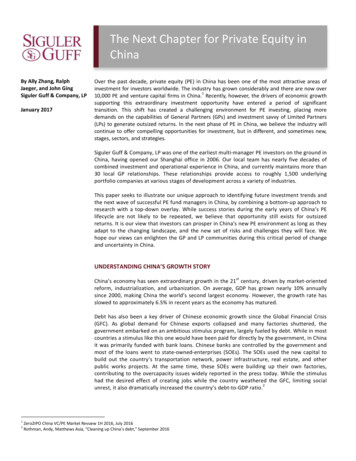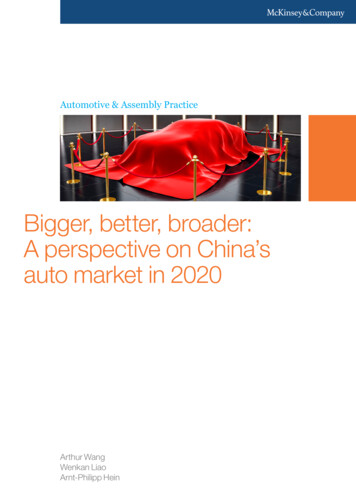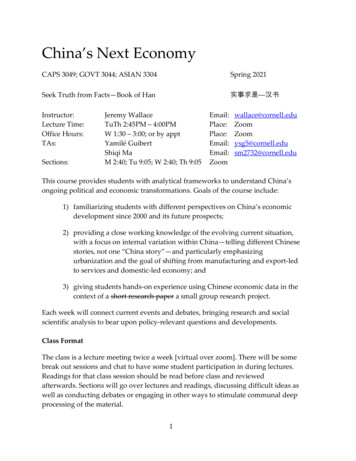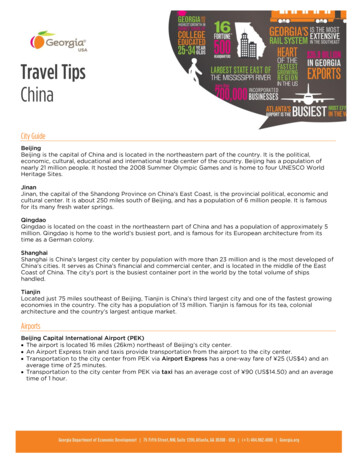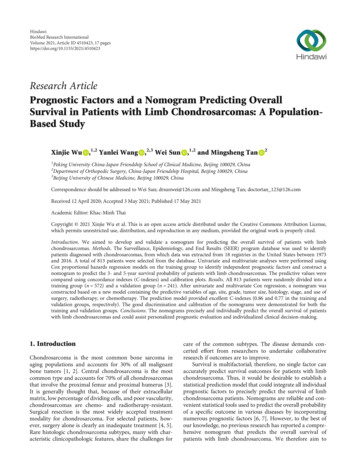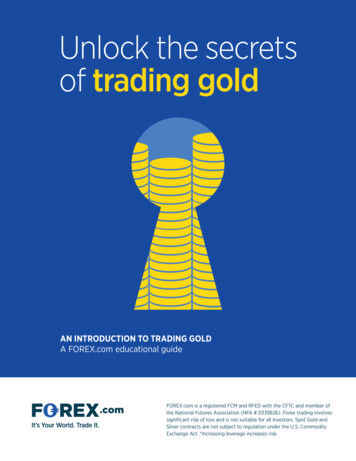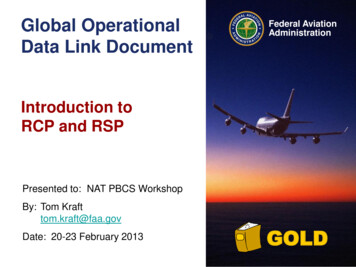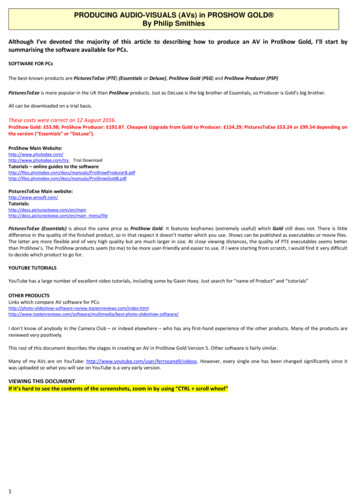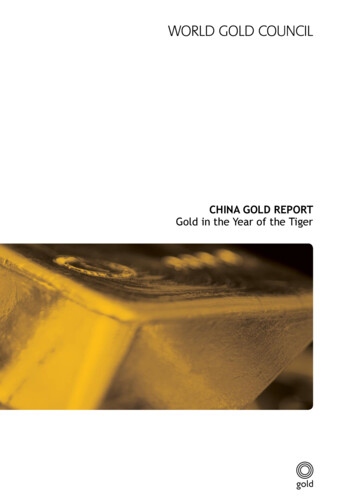
Transcription
CHINA GOLD REPORTGold in the Year of the Tiger
About The World Gold CouncilThe World Gold Council’s mission is to stimulateand sustain the demand for gold and to createenduring value for its stakeholders. The organisationrepresents the world’s leading gold miningcompanies, who produce more than 60% of theworld’s annual gold production in a responsiblemanner and whose Chairmen and CEOs form theBoard of the World Gold Council (WGC).As the gold industry’s key market developmentbody, WGC works with multiple partners to createstructural shifts in demand and to promote theuse of gold in all its forms; as an investment byopening new market channels and making gold’swealth preservation qualities better understood;in jewellery through the development of the premiummarket and the protection of the mass market; inindustry through the development of the electronicsmarket and the support of emerging technologiesand in government affairs through engagement inmacro-economic policy issues, lowering regulatorybarriers to gold ownership and the promotion ofgold as a reserve asset.The WGC is a commercially-driven organisation andis focussed on creating a new prominence for gold.It has its headquarters in London and operationsin the key gold demand centres of India, China,the Middle East and United States. The WGC isthe leading source of independent research andknowledge on the international gold market andon gold’s role in meeting the social and economicdemands of society.
China gold reportGold in the Year of the TigerContentsIntroduction5Gold demand in China – a new world of opportunity8Origins of gold demand8Overview of the early gold market9Recent economic trends10Demand continues to strengthen in China16 China’s market share of demand for gold and selected commoditiesGold price and seasonality Jewellery – potential demand growth given current low per capita level212223Investment – an opportunity to play catch up?27Industrial demand40Central Bank – the People’s Bank of China45Supply in China52Overview52Mine supply53Gold producers – domestic and foreign56Rising cost of production58Mine supply growth – taking a closer look at reserves and resources59Recycled gold65The long-term outlook for the Chinese gold market68Conclusion70
China gold reportGold in the Year of the TigerGold in the Year of the TigerEily Ong, World Gold CouncilExecutive summaryThe World Gold Council (WGC) believes that gold consumption in China willcontinue to catch up with the rest of the world following the deregulation ofthe Chinese gold market in 2001. Demand from China’s two largest sectors(jewellery and investment) reached a combined total of 428 tonnes in 2009 butdomestic mine supply contributed only 314 tonnes during the same year. Thisshortfall creates a “snowball” effect as China’s gold industry may not be ableto keep pace with the annual leap in domestic consumption despite rising to bethe world’s largest gold producer since 2007.Today, gold is regarded as a sign of prosperity, an ornament, a currency and anintegral part of Chinese religion.Although the country’s appetite for gold has grown, making China the secondlargest consumer in the world, demand in China per capita has a lot of catchingup to do to equal that of Western economies. In jewellery, the Chinese percapita consumption is one of the lowest at 0.26gm when compared to countrieswith similar gold cultures. If gold were consumed at the same rate per capita asin India, Hong Kong or Saudi Arabia, annual Chinese demand could increaseby at least 100 tonnes to as much as 4,000 tonnes in this sector alone. Nearterm inflationary expectations and rising income levels are likely to supportChart 1: Gold and cumulative gold supply and demand (tonnes) in ChinaChart 1: Gold and cumulative gold supply and demand (tonnes) in ative supply (t)Cumulative demand (t)Gold (Yuan/oz)Source: GFMS Limited, WGC estimates, the BLOOMBERG PROFESSIONALTM 919981997199619951994199319921991199019890
China gold reportGold in the Year of the Tigerthe investment case for gold as an asset class, especially given that Chineseconsumers are high savers and are looking to gold to protect their wealth.The People’s Bank of China (PBoC) is also playing an increasingly supportiverole for gold on the demand side. PBoC’s gold holdings are currently at 1.6%of its US 2.4tn total reserves – a fraction by international standards. If PBoCdecides to rebalance its books to its recent peak gold holding as a proportionof reserves of 2.2% in Q4 2002, WGC estimates it could account for a totalincremental demand of 400 tonnes at the current gold price.WGC analysis shows that, structurally, supply growth in China could bechallenging unless there is more funding directed to exploration. Assuming theUS Geological Survey’s figures are correct, China may exhaust existing goldmines in just six years. Despite the strong Yuan, total production costs have alsorisen by more than 30% in the last six years due to higher input costs (such asenergy and labour) and lower ore grades.The outlook for gold in China remains positive and WGC believes that thebalance between demand and supply in the Chinese gold market will continueto be in disequilibrium.In the longer term, if China continues to grow at near to the current rate ineconomic and wealth terms, gold consumption in China will continue to expandand has the potential to double during the next decade.
China gold reportGold in the Year of the TigerIntroductionGold plays a vital role in Chinese culture. The Chinese have a strong affinity togold when compared with Western countries. Gold has been present in Chinesehistory since the time of the Han Dynasty and even today is regarded as a signof prosperity, an ornament, a currency and an inherent part of Chinese religion.Weddings are important gold-buying occasions amongst the Chinese. Gold isalso traditionally bought as a gift during the Chinese New Year.According to the Chinese lunar calendar, 2010 is the Year of the Tiger and theyear which started on 14 February 2010, promises to be a year of excitement,prosperity and potential good luck for almost everyone. Those who make a realeffort will enjoy an auspicious wave of success when the brave and resilientTiger rules. Some Chinese also describe 2010 as the Golden Tiger Year.Today, China is the second largest gold consumption market and the world’slargest producer. Gold demand from China’s two largest sectors, (jewelleryand investment) reached a combined total of 428 tonnes in 2009. However,total domestic mine supply contributed only 314 tonnes during the same year.WGC studies indicate that in the long term, gold demand is likely to continueto accelerate, driven by investment demand in China, while current jewelleryconsumption is likely to continue to grow despite higher gold prices. Gold couldalso gain further momentum from central bank purchasing.We believe that since the abolition of the ban on the private ownership ofgold investment products in China, Chinese gold demand is catching up withWestern consumption levels. This is because market liberalisation tends to havea dramatic impact in a local market. In India, for example, its gold consumptionmore than doubled from around 300 tonnes in the early 1990s to over 700tonnes at the end of 2008 when the liberalisation process was in full swing.WGC estimates that a substantial increase in gold demand would take placeif demand in China were to rise to Japanese, USA or Taiwanese levels. In thiscase, total annual incremental demand ranges from another 1,000 tonnes atUSA and Japanese per capita consumption levels, and still more, if Chineseconsumption per capita were to rise to Taiwanese levels.Jewellery is by far the most dominant category of Chinese gold demand,accounting for almost 80% of all gold consumption in China in 2009. Chinesegold jewellery off-take increased 6% year-on-year to 347.1 tonnes in 2009 andChina was the only country to experience an improvement in jewellery demandlast year. WGC estimates that current per capita consumption of gold jewelleryin China is around 0.26gm. This level is low when compared to countries withsimilar gold cultures. If gold were consumed in China at the same rate percapita as in India, Hong Kong or Saudi Arabia, annual Chinese demand couldincrease by at least 100 tonnes to as much as 4,000 tonnes in the jewellerysector alone.
China gold reportGold in the Year of the TigerChina currently ranks fourth in annual retail investment demand in the world,behind Germany, the USA and Switzerland. Gold investment demand in Chinaentered a new era with the opening of the Shanghai Gold Exchange in 2002.At the end of 2009, China’s net retail investment in gold totalled 80.5 tonnes,up 22% year-on-year. Chinese consumers are typically high savers and goldinvestment amongst private individuals in China is developing rapidly. Goingforward, we believe that Chinese gold investment demand could be supportedby higher wealth and incomes and near-term inflationary expectations. Totalgold investment demand in China has grown in line with the country’s GDP andpopulation since 2001 and we expect this trend to continue in future. Gold’slower comparative volatility and low to negative correlations with mainstreamfinancial asset classes make it attractive as a risk management vehicle for bothinstitutional and retail investors in China.Chinese gold consumption in industrial applications has been steadily growingover the past ten years. Nevertheless, industrial demand for gold in China haslagged behind the Western world, but it is potentially a booming market inthe future owing to the ongoing rise of Chinese living standards and China’srise as the world’s manufacturing centre. Electronics continues to dominatethe domestic industrial demand landscape. Over the medium term, industrialdemand is likely to improve as global economic conditions and Chinese exportsimprove. Longer term, industrial demand for gold is likely to rise following thepotential launch of gold auto catalysts to reduce carbon monoxide emissions,and growth in mobile phone usage which is set to multiply among an expandingChinese middle class.China is the sixth largest official holder of gold, after the USA, Germany, theIMF, Italy and France. The gold reserves of the People’s Bank of China, (PBoC)as a percentage of total reserves are low by international standards, currentlyat 1.6%. WGC believes that there is ample scope for further growth as China stillhas the “fire power” left in its books should the country decide to increase itsgold reserves. The country’s total foreign exchange reserve is worth US 2.4tn,which is nearly two to 41 times the value of the G7 members’ total reserves atthe end of 2009. China is already a major investor in US Treasuries, but withuncertainty surrounding the future direction of the US dollar and the Yuan,the search for alternative international asset choices for the PBoC’s balancesheet may lead to a focus on gold. WGC estimates that if the PBoC decides torebalance its books back, for example, to its recent peak gold holding ratio of2.2% in Q4 2002, the incremental demand would amount to a further 400 tonnesat the current gold price. Even adding 10% from current levels of gold holdingswould translate into incremental demand of 100 tonnes.During the past decade, total Chinese gold mine output rose 84% and reacheda new record in 2009 of 313.98 tonnes, according to China Gold Association(CGA)1. China is already the world’s biggest producer and second largestconsumer of gold, but has only 4% of total global gold reserves, according tothe US Geological Survey (USGS) in 2009. Assuming the USGS’ recent figuresare correct, China may exhaust existing gold mines in six years from now. This1Xinhua News Agency, 31 January 2010
China gold reportGold in the Year of the Tigercould occur more rapidly if demand for gold in China experienced a suddensurge from current levels. However, China’s gold resources are still relativelyundiscovered and could create new investment opportunities. WGC also foundthat the total cost of production in China has risen by more than 30% in the lastsix years as a result of higher input costs (such as energy and labour) and lowerore grades. Therefore, WGC believes that Chinese gold supply growth may bemore challenging and is likely to decline unless there is further investment in theChinese gold industry.Recycled gold supply is a wildcard in China. However, we believe that Chineseconsumers are in the process of accumulating gold, which suggests that theyare less willing to sell back their holdings in response to higher gold prices.Although it is now eight years into the gold bull market, the Chinese goldindustry is simply not responding fast enough to bring in new supply. Theseeffects combined create a “snowball” effect in China whereby the domestic goldindustry may not be able to catch up with the annual leap in local consumption.Each year, China’s demand for gold continues to grow, and the gap increasesbetween new demand and new supply.China has recently provided strong support for global gold demand during aperiod of weakness in other parts of the world in the gold industry. In a periodof ongoing economic and financial uncertainty gold’s role as a monetary asset,a global currency and an insurance policy providing protection against theunknown, all make gold an attractive asset class.Gold has performed impressively for nearly a decade, both in China andinternationally. Today, the combination of a healthy outlook for gold demandand its relatively inelastic supply in China may be seen as perfect conditionsfor gold and China is well placed to capitalise on this. In the longer term, WGCbelieves that China could have a long period of strong demand ahead and theconsumption of gold in China has the potential to double in the next decade.
China gold reportGold in the Year of the TigerGold demand in China – a new worldof opportunityOrigins of gold demandGold is a symbol of wealth in Chinese culture. The children of affluent Chinesefamilies are said to be born not with a silver spoon as in Britain, but with agolden chopstick in their mouths. In Chinese tradition, gold is given as a gift onbirthdays, mother’s day, births and at Chinese New Year. Gold is also boughtas part of the wedding jewellery which forms a major part of total jewellerydemand in China.According to the author, Timothy Green2, the Chinese have long adored gold.In 23 AD, Emperor Wang Mang who founded the Xin Dynasty held the world’slargest reserves of gold, approximately 155 tonnes in his treasury. Althoughtoday China is the world’s second largest gold consumer and largest globalproducer, the country was a relative late-comer to the gold scene. Archaeologicaldiscoveries in China have found early evidence of copper and bronze in northernChina around 2000 BC however the first signs of gold were discovered later,after 1500 BC and not before 1000 BC.Gold first played a role as a money currency in the Southern state of Zhou.The commodity has always been measured in weight – liang in Mandarin andtael in Cantonese indicating one Chinese ounce. However, the actual weightof the ounce has changed. Today, one liang / tael weighs 37.43 grams/12 ozcompared to 15.25 grams/0.49 oz during the Han Dynasty era in 206 BC. PeterJ. Golas, in his study of gold mining in China, observed that gold bullion wasextensively used in commercial transactions during the Han period3.After the collapse of the Han Dynasty, the tradition of minting gold coins did notdevelop for many centuries during the reigns of the Tang, Ming, and Qing. Thecurrency of the time was copper, although silk was used to settle transactions4.Gold was used among the nobility, for settlements among the different factionsin China and for hoarding wealth.During the period of the Six Dynasties (AD 222-589), demand for gold rosewhen Buddhism swept across China. The arrival of the religion from India andTibet influenced Chinese Buddhist worshippers to make gold offerings, to buildornate stupas (pagodas) and to bequeath gold statues in the Buddha’s image.According to John Kieschnick, the amount of gold used to make Buddhistimages was so overwhelming that the Chinese government dictated the meltingdown of Buddhist images in order to supply the metal for construction and foruse by the military5.2Timothy Green, author of The Ages of Gold3Peter J. Golas, Science and Civilisation in China, 19994Han Schu, Food and Money in Ancient China, 19505John Kieschnick,The Impact of Buddhism on Chinese Material Culture, 2003
China gold reportGold in the Year of the TigerOverview of the early gold marketPrior to 2002, the gold market in China was tightly regulated from productionthrough to retail distribution. Gold prices and quotas were dictated by thePeople’s Bank of China (PBoC) jointly with other central authorities. Permissionwas required from the PBoC to export gold and imports of gold jewellery weresubject to a 60% import tariff (albeit a 40% cut from 100% in 1996). From 1996,China hastened the reform and liberalisation process. The freeing of the goldmarket included the use of the Shenzhen special economic zone to loosenjewellery retail price controls and to make the Yuan convertible (the Yuan isalso referred to as Renminbi or CNY). It was not until October 2002 that theShanghai Gold Exchange was established to replace the PBoC’s gold purchaseand allocation system. China also became a full member the World TradeOrganisation (WTO) on December 2001 and has since worked to encourage themodernisation of mining laws in order to bring investment and mining expertisefrom the West into China.China Gold Association (CGA) was established in November 2001 and plays anactive role in China’s gold industry. CGA acts as a bridge between the Chinesegovernment and gold producers in protecting business interests and providinginformation, consultancy, co-ordination and intermediary services for them.The Industrial and Commercial Bank of China (ICBC) and other commercialbanks played a significant role in preparing for the launch of a fully functioninggold market. According to China Internet Information Center (www.china.org.cn),ICBC had actively participated in setting up the operations of the Shanghai GoldExchange and offered a range of services including clearing, warehousing, goldtrading, leasing, financing for gold projects, gold purchasing, gold investmentprojects, gold import and export and individual gold trading.Chart 2: Organisation structure of China gold industryChart 2: Organisation structure of China’s gold industryThe State CouncilCabinetState-owned AssetsSupervision andAdministrationCommission (SASAC)Control State assetsand investmentsMinistry of Landand Resources(MOLAR)Licensing AuthorityChina National Gold GroupCorporation (CNGGC)Wholly-owned stateholding companyNational Developmentand ReformCommission (NDRC)Policy and PlanningChina GoldAssociation(CGA)Trade organisationSource: WGC and China Financial ServicesPeople’s Bank ofChina (PBoC)Central BankGold supplier to, andsupervisor of SGEShanghai Gold Exchange(SGE)Membership Tradersfor Gold, Platinumand Silver
10China gold reportGold in the Year of the TigerRecent economic trendsThe Chinese economy has grown rapidly over the last decade. China’s increasingpersonal income and consumption, aided by strong growth in its gross domesticChart 3: Gold(Yuan/oz)and ChinaReal GDPGrowthproduct(GDP)(9.3%in 2007,9.0%in (%)2008 and 8.7% in 2009) have nurturedthe development of the luxury goods industry in the country.Chart 3: Gold (Yuan/oz) and China real GDP growth (%)Yuan/ozYoY 041,000200198019841988Gold (Yuan/oz)199219962000200420082012EReal GDP growth (YoY%)Chart 4: Gold (Yuan/oz) and China Nominal GDP (US bn)Source: IMF (World Economic Outlook Update, January 2010), the BLOOMBERG PROFESSIONALTM serviceChart 4: Gold (Yuan/oz) and China nominal GDP (US 9801984Gold (Yuan/oz)1988199219962000200420082012ENominal GDP (US bn)Source: IMF (World Economic Outlook, October 2009), the BLOOMBERG PROFESSIONALTM serviceToday the country’s large balance of payments surplus, rapid economic growth,the high saving rate and the aggressive fiscal stimulus to offset global recession,make China a target destination of global foreign investment. China’s foreigndirect investment (FDI) in January 2010 rose 7.8% year-on-year to US 8.13bn,marking the sixth consecutive month of year-on-year growth.
11China gold reportGold in the Year of the TigerChart 5: Gold (Yuan/oz) and China FDI (US bn)Chart 5: Gold (Yuan/oz) and China FDI (US bn)Yuan/ozUS 021,0000Nov-960Nov-98Nov-00China FDI (US bn)Nov-02Nov-04Nov-06Nov-08Gold (Yuan/oz)Source: the BLOOMBERG PROFESSIONALTM serviceThe graphs below show the rapid recovery of the HSBC China ManufacturingPurchasing Managers’ Index (PMI) during and after the credit crisis. The indexis a measure of manufacturing activity across China. The rapid recovery in theindex and the continued strong economic growth rate being experienced byChina has meant that the impact of the credit crisis has been relatively modestcompared with the majority of the Western world, which faced deep recessionin 2009 and is only now beginning to recover.Chart 6 Gold (Yuan/oz) and Chinese PMI Manufacturing IndexChart 6: Gold (Yuan/oz) and Chinese PMI manufacturing 0404,0003,000Jan-0535Sep-05May-06Gold (Yuan/oz, LHS)Jan-07Sep-07May-08Jan-09PMI manufacturing index (points, RHS)Source: the BLOOMBERG PROFESSIONALTM serviceSep-09
12China gold reportGold in the Year of the TigerChart 7: Gold (Yuan/oz) and China PMI New OrdersChart 7: Gold (Yuan/oz) and China PMI new 55,000404,0003,000Jan-053530Sep-05May-06Gold (Yuan/oz)Jan-07Sep-07May-08Jan-09Sep-09China new orders PMI (points)Source: the BLOOMBERG PROFESSIONALTM serviceChina now represents more than 20% of the major mining companies’ sales ofmetals and 30-50% of the global raw materials demand.Since the credit crisis began, China has been adjusting its economic modelaway from reliance on exports and Western consumers, and towards moredomestically driven demand – a market with over 1.3bn consumers. In orderto achieve this, China has been aggressively embarking on fiscal spending tosecure the supply of raw materials and to facilitate the country’s industrialisationand urbanisation programmes.This includes a strategic purchasing policy (i.e. restocking), implementedthrough the State Reserves Bureau Agency, resulting in the purchase ofcommodities such as grains, copper, nickel and aluminium.China’s restocking strategy has also taken the form of acquisitions of naturalresource producers around the globe.
13China gold reportGold in the Year of the TigerTable 8: List of selected Chinese natural resource acquisitions tyValue(US mn)2009Minmetals100% stake in OZ Minerals, the world’ssecond largest zinc minerAustraliaZinc1,7002009Shenzhen ZhonginLingnan Nonfermet50.1% stake in Perilya LtdAustraliaZinc and lead292009China Non-FerrousMetals IndustryTerramin Australia’s lead and zinc supplies inAlgeriaAustraliaLead and zinc322009Jilin Ji En Nickel IndustryCo.Bought 51% of Ontario’s Liberty Mines, anickel producerCanadaNickel242009Hunan Valin Iron & Steel16% stake in Fortescue MetalsAustraliaIron ore2008ChinalcoBought 9% stake in Rio Tinto GroupU.K.Diversified2008Wuhan Iron & Steel50% stake in Centrex Metals Ltd, five iron oreprojectsAustraliaIron ore2008Western Mining Co Ltd.10% stake in FerrAus Ltd.AustraliaIron ore162008Jinchuan Group Ltd.100% stake in Tyler ResourcesCanadaCopper2142008Shougang Corporation19.9% interest in Prosperity Resources Ltd.AustraliaIron ore42008Haoning Group9.55% stake in Jupiter Mines Ltd.AustraliaIron ore2008Aluminium Corporationof China Ltd. (CHALCO)40% stake in Saudi Aluminium projectSaudi ArabiaAluminiumN/a2008Hunan NonferrousMetals Corporation. Ltd87.8% stake in Abra Mining Ltd.AustraliaBase metals1112008Citic ResourcesHoldings Ltd.20.39% stake in Macarthur Coal Ltd.AustraliaCoal172008Hunan Valin Steel Tube& Wire Co.11.39% stake in Golden West Resources Ltd.AustraliaIron ore272008Sinosteel Corporation98.52% stake in MidwestAustraliaIron ore1,3002008Zhaojin MiningControlling stake in a gold mine in HebeiprovinceChinaGold492008China National GoldGroupBought Canadian listed gold producer,Jinshan GoldCanadaGold2062007Sinosteel Corporation67% stake in Zimasco HoldingsZimbabweFerrochromeN/a2007Zijin Mining20% interest in a gold project from LepantoConsolidated Mining Co.PhilippinesGold2007ChinalcoPeru Copper Inc.PeruCopper8602007Anshan Iron & SteelGroupAustralian iron ore joint venture withGindalbie Metals Ltd.AustraliaIron ore1,6002006China National OverseasOil Corporation.45% stake in the licence covering the OML130 Nigerian oil fieldsNigeriaOil2,70077014,000127455Source: the BLOOMBERG PROFESSIONAL service, Reuters, China Mining, Metal Bulletin, Wall StreetJournal, Chinalco Aluminum Corporation of China LimitedWe believe this to be a long term strategy of China – to invest its wealth, tostimulate industrialisation and urbanisation, and to secure supplies andproduction of key raw materials.In 2009, governments and central banks around the world implemented variousliquidity strategies (such as interest rate cuts, fiscal stimulus, and quantitativeeasing) as a panacea to the global crisis. Table 9 shows the fiscal stimulus fromselected countries, amounting to over US 1.7tn. This was in addition to variousbailouts, the Obama plan and the Troubled Asset Relief Program plan (TARP),which together totalled over US 20-30tn on a global basis.
14China gold reportGold in the Year of the TigerTable 9: Fiscal stimulus announcements in 2008Selected countryUS bnCommentsUSA825Over US 200bn on infrastructure program.China586Chinese stimulus package worth around 13% of GDP. Almost two-thirds ofthis package in infrastructure spending (railways, airports, power grid andfor reconstruction).Europe193Includes the following spending on infrastructure: @18bn in Germany, @8bnin Spain, @4bn in France, @17bn in Italy and SEK1bn in Sweden.Japan73In April 2009, Reuters reported that the cumulative size of the Japanesestimulus package approached US 154bn (or 3.1% of 2008 GDP).Mexico32Stimulus package amount to 1% of GDP and includes a US 14bnspending on infrastructure.Russia20According to United Nation’s Economic and Social Commissions for Asiaand the Pacific, total fiscal stimulus announced in Aril 2009 amount to RUB3tn (US 90bn) or 7.2% of 2008 GDP.Argentina16Almost two-thirds of this package allocated to road infrastructure projectsand social improvements.Singapore14Stimulus package totalling SGD20.5bn (US 14bn) and includes aUS 2.9bn infrastructure spending.Australia7Infrastructure program includes road funding, construction projects and aA 1.2bn railway construction by the Australian Rail Track Corporation.India4Stimulus package amount to 200bn Indian Rupees (US 4bn) or 0.4% of2008 GDP.Source: the BLOOMBERG PROFESSIONALTM service, Financial Times, News run, United Nation’s Economicand Social Commissions for Asia and the Pacific, ReutersChina announced a fiscal stimulus measure of approximately US 586bn (or 4tnYuan) to improve its rail, road and air transport links. This measure also creatednew demand for raw materials during 2009.At the end of February 2010, the growth of China’s M2, the broad measurementof money supply, jumped 26% year-on-year on the back of strong fixed assetinvestments and related lending growth especially from big state-owned banksto add credit support to infrastructure projects.Chart 10: Gold (Yuan/oz) and Money supply M2 (Yuan bn) in ChinaChart 10: Gold (Yuan/oz) and Money supply M2 (Yuan bn) in ChinaYuan/ozYuan 000Sep-05May-06Gold (Yuan/oz)Jan-07Sep-07May-08Money supply M2 (Yuan bn)Source: the BLOOMBERG PROFESSIONALTM service, PBoCJan-09Sep-09
15China gold reportGold in the Year of the TigerWe believe that a majority of the economies around the world still face strongheadwinds as a result of the credit crunch. This includes huge deficits whichsignal currency uncertainty, sluggish economic growth, elevated unemploymentin the near future, downward pressure on asset values and inflationary risks.Clearly, the global banking sector is not out of danger and the availabilityof credit remains constrained, with some banks still on life support. Somecommercial banks remain unwilling to lend, forcing bond and rights issues bycompanies around the globe.Public debt levels in the USA and Eurozone are recognised by most commentatorsas unsustainable. According to the IMF and the European Commission, thegeneral government debt as a percentage of GDP in the Eurozone will rise from69.3% in 2008 to 79.3% in 2009, 85.4% in 2010 and 90.7% in 2011.The continued problems in the banking sector around the world suggest thatthe credit multiplier is not functioning. The IMF reported a total realised loss ofapproximately US 1.2tn by banks and expects additional write downs or lossprovisions of US 1.6tn, suggesting that banks are unlikely to expand credit inthe near-term. Whilst continued expansion in China has moderated the impactof the credit crunch globally, the prospect of significant overheating of theChinese real estate and stock markets are also raising considerable concerns.The table below shows IMF estimates of the global bank loans and securitiesholdings and total write-downs between 2007 and 20106. According to theIMF, Asia banks have less exposure in loans a
According to the Chinese lunar calendar, 2010 is the Year of the Tiger and the year which started on 14 February 2010, promises to be a year of excitement, prosperity and potential good luck for almost everyone. Those who make a real effort will enjoy an auspicious wave of success w

